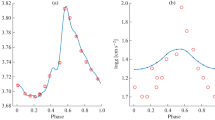Abstract
In recent years pulsating stars in the lower part of cepheid instability, e.g. δ scuti and γ doradus stars, have been indicated as good laboratories to sound stellar interior through a seismological approach. The most relevant amount of data about pulsating stars derives from light curves, colour curves and photospheric absorption line profiles. Once outlined the relations of such observables with fundamental pulsational models, we review the most used principles and techniques to work out some seismological information from these data.
Preview
Unable to display preview. Download preview PDF.
Similar content being viewed by others
References
Aerts, C., De Pauw, M., Waelkens, C., 1992, A&A, 266 294
Baade, D., 1926, Astron. Nachr., 228 359
Balona, L.A., 1986a, MNRAS, 219 111
Balona, L.A., 1986b, MNRAS, 220 647
Balona, L.A., 1986c, MNRAS, 223 621
Balona, L.A., 1987, MNRAS, 224, 41
Bossi, M., Mantegazza, L., Nuíïez, N.S., 1998, A&A, 336 518
Breger, M., 1991, A&A, 250, 107
Dziembowski, W., 1977a, Acta Astron., 27 95
Garrido, R., Garcia-Lobo, E., Rodríguez, E., 1990, A&A, 234 262
Gies, D.R., Kullavanijaya, A., 1988, ApJ, 326 813
Gies, D.R., Kullavanijaya, A., 1988, ApJ, 326 813
Gray, D.F., 1991, The Observation and Analisis of Stellar photospheres, ed. Cambridge Univerity Press
Kambe, E., Ando, H., Hirata, R., 1990, PASJ, 42, 687
Kennelly, E.J., Walker, G.A.H., Merryfield, W.J., 1992, ApJ, 400 L71
Ledoux, P., 1951, ApJ, 114 373
Mantegazza, L., Poretti, E., Zerbi, F.M., 1995, A&A, 299 427
Schrijvers, C., Telting, J.H., Aerts, C., Ruymaekers, E., Henrichs, H.F., 1997, A&AS, 121 343
Telting, J., Schrijvers, C., 1997, A&A, 317 723
Wesselink, A.J., 1947, BAIN, 10 256
Watson, R.D., 1988, ApSS, 140 255
Zerbi, F.M., et al, 1999, MNRAS, 303 275
Author information
Authors and Affiliations
Editor information
Editors and Affiliations
Rights and permissions
Copyright information
© 2000 Springer Science+Business Media Dordrecht
About this chapter
Cite this chapter
Zerbi, F.M. (2000). Simultaneous Light Curve, Color Curve and Line Profile Fitting for Pulsating Stars. In: İbanoğlu, C. (eds) Variable Stars as Essential Astrophysical Tools. NATO Science Series, vol 544. Springer, Dordrecht. https://doi.org/10.1007/978-94-011-4299-1_11
Download citation
DOI: https://doi.org/10.1007/978-94-011-4299-1_11
Publisher Name: Springer, Dordrecht
Print ISBN: 978-0-7923-6084-1
Online ISBN: 978-94-011-4299-1
eBook Packages: Springer Book Archive




